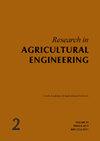Effect of drying temperature in hop dryer on hop quality
Q3 Agricultural and Biological Sciences
引用次数: 1
Abstract
One of the qualitative characteristics of both green and dried hops is the content of hop essential oils which are contained in a quantity of 0.5 to 3.5%, depending on the hop variety. These essential oils are heat labile substances because the temperature has an influence on their content. Hop cones, dried either in belt or chamber dryers, are exposed to a drying medium temperature of 55 to 60 °C for the entire duration of drying, i.e. for 6–8 hours. Under current drying conditions there is a loss of approx. 15 to 25% of the total content of essential oils present in hops before drying. In case of special aroma hop varieties, such losses lead to a decline in the product quality. Comparative measurements have been carried out with a laboratory equipment to find out whether more aromatic essential oils are retained in hop cones at a drying temperature of 40 °C compared to a drying temperature of 60 °C. The measurement carried out with the most common variety of Saaz hop concluded that the essential oil losses were lower by 33.4% at a drying temperature of 40 °C, and with other seven mostly hybrid varieties the losses were lower on average by 13.9% than at a drying temperature of 60 °C. The measurements proved that each of the varieties retained, to a significant extent, its content of essential oils in the dried hop cones at a drying temperature of 40 °C.酒花干燥机干燥温度对酒花品质的影响
青啤酒花和干啤酒花的质量特征之一是啤酒花精油的含量,根据啤酒花品种的不同,其含量为0.5至3.5%。这些精油是热不稳定物质,因为温度对其含量有影响。在带式或室式干燥机中干燥的啤酒花锥,在整个干燥过程中暴露在温度为55至60°C的干燥介质中,即6-8小时。在目前的干燥条件下,损失约为。在干燥前啤酒花中存在的总精油含量的15 - 25%。对于特殊香气的啤酒花品种,这种损失会导致产品质量下降。用实验室设备进行了对比测量,以确定在40°C的干燥温度下与60°C的干燥温度下,啤酒花锥中是否保留了更多的芳香精油。结果表明,在干燥温度为40°C时,最常见的Saaz hop品种的精油损失降低了33.4%,而在干燥温度为60°C时,其他7个杂交品种的精油损失平均降低了13.9%。测量证明,在40°C的干燥温度下,每个品种在干燥的啤酒花球果中都保留了相当程度的精油含量。
本文章由计算机程序翻译,如有差异,请以英文原文为准。
求助全文
约1分钟内获得全文
求助全文
来源期刊

Research in Agricultural Engineering
Engineering, agriculture-
CiteScore
1.40
自引率
0.00%
发文量
21
审稿时长
24 weeks
期刊介绍:
Original scientific papers, short communications, information, and studies covering all areas of agricultural engineering, agricultural technology, processing of agricultural products, countryside buildings and related problems from ecology, energetics, economy, ergonomy and applied physics and chemistry. Papers are published in English.
 求助内容:
求助内容: 应助结果提醒方式:
应助结果提醒方式:


